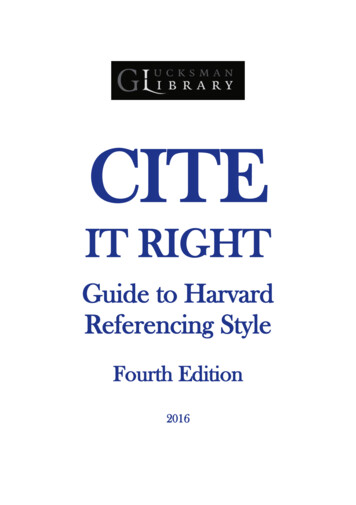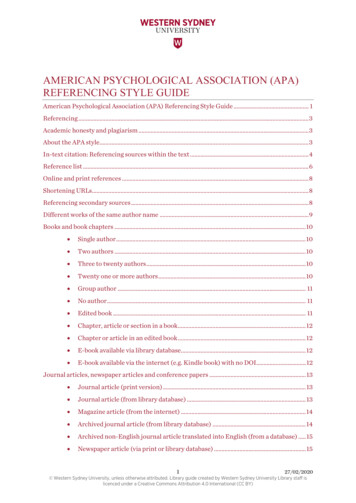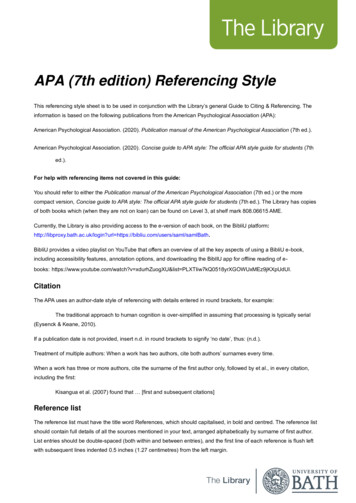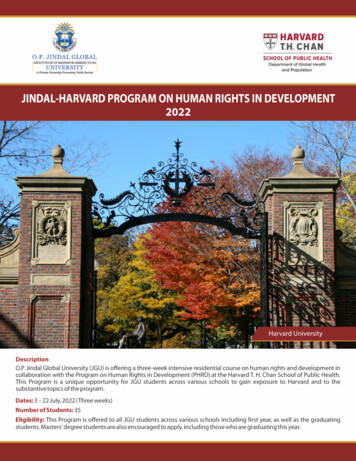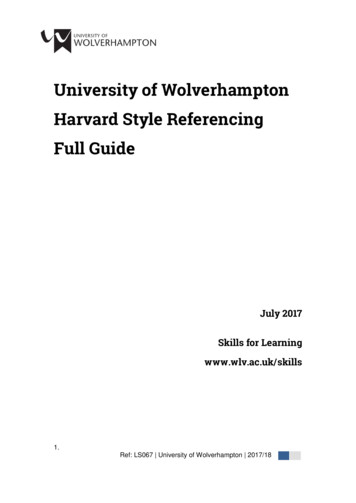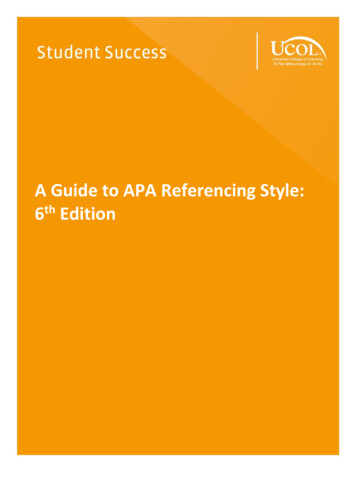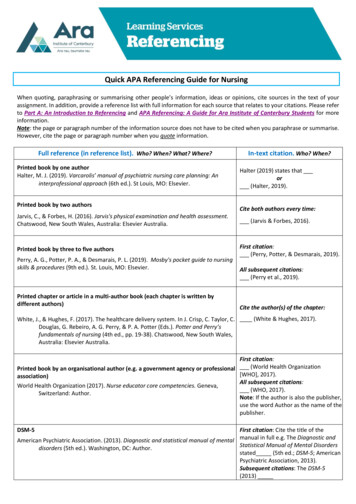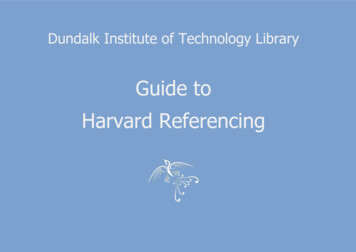
Transcription
Dundalk Institute of Technology LibraryGuide toHarvard Referencing
DkIT De Chastelain LibraryContact: library@dkit.ieGeneral disclaimer: This guide is intended to provide guidance on how to reference a wide range of materials, but it does not cover everysituation. Users should seek advice from their lecturer on the appropriate style to use for specific situations. While DkIT De Chastelain Libraryhas taken every precaution in compiling this guide, it does not warrant or assume any legal liability or responsibility for the accuracy,completeness, or fitness of the content.Please ensure you are using the most up-to-date version, available on DkIT Library’s website.Last updated: 12th September 2019
CONTENTS1 INTRODUCTION . 12.3.1.1Why is referencing important? . 11.2What is the Harvard style of referencing? . 1QUOTING, PARAPHRASING AND SUMMARISING . 32.1Short direct quotations . 32.2Long direct quotations. 32.3Changing a direct quotation . 32.4Paraphrasing and summarising. 3GENERAL GUIDELINES . 53.1 Citing page numbers . 53.2 One author . 53.3 Two authors . 53.4 Three or more authors . 63.5 Works with no author . 63.6 Source cited within another source . 63.7 Multiple sources cited together . 73.8 Multiple authors with the same surname and the same year . 73.9 Multiple publications by the same author in different years. 73.10 Multiple publications by the same author in the same year . 73.11 Works with no date or uncertain date . 83.12 Printed works with no place of publication . 83.13 Printed works with more than one place of publication . 8
3.14 US States in the place of publication . 83.15Double-barrelled surnames . 83.16 Author with a title (Dr., Professor, Sir) . 83.17 Capital letters . 93.18 Repeating a citation . 9These are not part of the Harvard System of Referencing but are commonly used with all systems. . 93.19 Citing interviews/surveys carried out by yourself . 94.REFERENCING AND CITING GUIDELINES . 104.1Books and E-Books . 104.1.1Book . 104.1.2Edited book . 104.1.3Chapter in edited book . 114.1.4Book series . 114.1.5Reprinted book . 114.1.6Book review . 124.1.7Translation . 124.1.8Play . 124.1.9Introduction to a book . 134.1.10Reference work with no author . 134.1.11Exhibition catalogue . 134.1.12E-Book: Website or library database . 144.1.13E-Book: E-Reader (e.g. Kindle) . 154.1.14Audiobook . 15
4.2Journals and magazines . 164.2.1Journal/magazine article: Print . 164.2.2Journal/magazine article: Website or library database . 164.3Correspondence and communication . 184.3.1Letter to a newspaper . 184.3.2Letter in historical archive . 184.4Course material . 194.4.1Course material: Print . 194.4.2Course material: Online . 194.5Internet . 204.5.1Webpage . 204.5.2Online video (e.g. YouTube) . 204.5.3Mailing list/ Discussion Forum/ Blog/ Twitter/ Facebook . 204.5.4Wiki. 214.5.5Institutional Repository. 224.5.6SlideShare . 224.5.7Pinterest . 234.5.8Mobile application . 234.5.9Video conferences, Webinars, Webcasts, lectures and seminars . 234.6Images . 244.6.1Image, Figure, Illustration, Photo or Table: Print . 244.6.2Image, Figure, Illustration, Photo or Table: Print: Web . 244.6.3Map . 25
4.7Legislation . 264.7.1Act/Statutory Instrument . 264.7.2EU Directive . 264.7.3Government Report: Print . 274.7.4Government Report: Website. 274.7.5White/Green Paper: . 274.7.6White/Green Paper: . 284.8Newspapers and media . 294.8.1Newspaper article: Print . 294.8.2Newspaper article: Online . 294.8.3Radio / television programme . 304.8.4Radio / television interview or contribution . 304.8.5Radio / television advertisement . 304.8.6Archived radio/television programme/podcast . 314.8.7Film / DVD / Video . 314.8.8Microfilm / Microfiche / CD ROM . 314.8.9Press release . 314.8.10Speech: Live . 324.8.11Speech: Recorded / transcript online . 324.9Musical works and live performances. 334.9.1Recordings: Album. 334.9.2Recordings: Track from album . 334.9.3Sheet Music . 33
4.9.4Live performance: Concert . 344.9.5Live performance: Play . 344.10Conference papers, reports and policies . 354.10.1Conference paper: published in printed proceedings . 354.10.2Conference paper: published in proceedings on website or library database . 354.10.3Unpublished conference paper . 364.10.4Research Report: Print . 364.10.5Research Report: Website . 364.10.6Annual report: Print . 374.10.7Annual report: Website . 374.10.8Policy document: Print . 374.10.9Policy document: Website . 384.10.10 Case study. 384.114.11.1Patent . 394.11.2Standard: Print . 394.11.3Standard: Website or library database . 404.125.Technical / commercial / industrial . 39Theses and miscellaneous material . 414.12.1Thesis/dissertation . 414.12.2Leaflet/flyer/booklet/ newsletter/in-house publication/grey literature . 414.12.3Medicine data sheet . 42Commons elements in the reference list . 43
1INTRODUCTION1.1Why is referencing important?Referencing is the acknowledgement of any material used in the writing of your work. It is used to: let the reader find the source material you have used show the research you have carried out to place your work in context and reach your conclusions back up your arguments avoid plagiarism, cheating or copyingPlagiarism is the use of another’s work (or your own previous work) without a clear acknowledgement of the source of the information.Another’s work refers not just to his/her words; it also includes ideas, images, charts, data, music, and so on. Plagiarism may be accidental ordeliberate, and is considered a serious disciplinary offence in Dundalk Institute of Technology (DkIT).1.1.1Common knowledgeYou do not need to acknowledge a source for information that is common knowledge. Common knowledge is information that either the generalpublic or the average reader in your subject area would know. If you are unsure if something is common knowledge you should include areference for it.1.2What is the Harvard style of referencing?A number of different referencing styles exist. DkIT uses the Harvard style of referencing, which is outlined in this guide. Your lecturer mightwant you to use a different style of referencing; you should check this with him/her before beginning your work.The Harvard style of referencing consists of two elements:1. Citation An indication, in the main text of your work, that you have used someone else’s work. This usually takes the form (Author’s surname Year). Example: (Drury 2013). Where the author’s name(s) occurs naturally in the text, the year follows in brackets. Example: Drury (2013) outlines the keysteps required.1
2. Reference list The detailed list of sources cited in your work, in other words the sources from which you have obtained your information. The reference list appears at the end of your work. It is arranged alphabetically by author’s surname.1.2.1Bibliography and webographyA reference list contains only sources cited in the main text of your work. In general, you are only required to produce a reference list, but youmay be asked to provide a bibliography instead of or in addition to the reference list. A bibliography is list of all sources and backgroundmaterial consulted, whether or not you have cited the source in your text. It is in the same format as the reference list. A separate webographycan also be included at the end of the bibliography if you have used information from websites.2
2. QUOTING, PARAPHRASING AND SUMMARISING2.1Short direct quotationsA direct quotation of less than two lines long should: be inserted directly into the text without putting it on to a new line commence and end with quotation marks include the citation at the end2.2Long direct quotationsA direct quotation consists of the actual words used by the author. A direct quotation of more than two lines long should: commence on a new line be indented from the main text at both left and right margins be typed in smaller font size to the main text of the work be typed in single-line spacing not have quotation marks include the citation at the end2.3Changing a direct quotationWhere you make changes to a direct quotation you must follow the rules below: where you leave out words, phrases, or paragraphs from a quotation, whether from the beginning, middle or end, you must showthis with ellipsis points (i.e. three spaced dots). There should be a space before each dot unless the first dot is a full stop, and aspace after the last if a word follows, e.g. Ward (2014, p.17) believes this “shows diligence . . . and quality”. where you want to insert your own words, or different words, into a quotation, you must put them in [square] brackets where there is an error, e.g. a spelling mistake or wrong date, in the original quotation, type [sic] at the point where the error occurs. if you underline, embolden or italicise any part of the quotation for emphasis, you must state that the emphasis is your own, e.g.(O’Connor 2012, p.45, author’s italics). if any part of the original is underlined, or in bold, or in italics you must state that is how it is in the original, e.g., (Smyth 2014, p.44,italics in original)2.4Paraphrasing and summarisingYou may wish to paraphrase or summarise a piece rather than quoting directly.3
Paraphrasing is when you put someone else’s work into your own wordsSummarising is when you give an outline of the main points of a passage, chapter or bookDo not change the original meaningYou must still acknowledge the original author as the idea is not your own. See section 3.1 for when to include page numbers.Author's original textBrand loyalty exists when consumers have a preference for the products of established companies. A company can create brand loyalty bycontinuously advertising its brand-name products and company name, patent protection of its products, product innovation achievedthrough company research and development programs, an emphasis on high quality products, and exceptional after-sales service.Reference: Jones, G. and Hill, C. (2013). Theory of strategic management: with cases. 10th ed. Mason: South-Western.Paraphrasing exampleJones and Hill (2013, p.47) explain that brand loyalty means a customer’s preference for products from well-known companies. Theyoutline ways in which a company can create brand loyalty, including repeated advertising of the product and company brand-name, takingout a patent on the product, research driven innovation, and a high standard of after-sales service.Summarising exampleJones and Hill (2013, p.47) outline the various ways by which a company can create brand loyalty through advertising, patent protection,innovation, quality, and after-sales services.4
3. GENERAL GUIDELINESThe following guidelines apply to all material types. See Section 4 for details on how to reference specific material types.3.1 Citing page numbersInclude page numbers in the citation when you quote from, paraphrase or summarise a specific section inthe source. Exclude page numbers when you refer to a larger section or to an entire work.Add a comma after the year and use p. for a single page and pp. for a page range.Example citation(Byrne 2014, p.56)(Byrne 2014, pp.17-19)3.2 One author(Author’s surname Year)Example citation(Drury 2013)Example referenceDrury, C. (2013). Management accounting for business. 5th ed. Andover: Cengage Learning.3.3 Two authorsList the authors as they appear on the source material, not alphabetically.(First author’s surname and second author’s surname Year)Example citation(Aldridge and O'Dwyer 2013)Example referenceAldridge, P. and O'Dwyer, L. (2013). Practical emergency and critical care veterinary nursing. Chichester:Wiley-Blackwell.5
3.4 Three or moreauthorsThe first author is as listed on the source material, not alphabetical order. Include the first author onlyfollowed by ‘et al.’ in the citation but name all authors in the reference list.(First author’s surname et al. Year)Example citation(Torrington et al. 2014)Example referenceTorrington, D., Hall, L., Taylor, S. and Atkinson, C. (2014). Human resource management. 9th ed. Harlow:Pearson.3.5 Works with no authorWhere you cannot establish the author(s) of a work, include the title within the brackets in place of theauthor’s surname.(Title Year)Example citation(Collins English dictionary 2012)3.6 Source cited withinanother sourceIt is recommended that you only cite and reference sources that you have seen
A number of different referencing styles exist. DkIT uses the Harvard style of referencing, which is outlined in this guide. Your lecturer might want you to use a different style of referencing; you should check this with him/her before beginning your work. The Harvard style of referencing consists of two elements: 1. Citation
